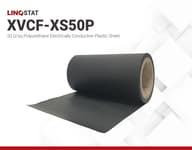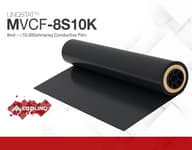Conductive Plastic Films
CAPLINQ offers a range of LINQSTAT-branded electrically conductive and antistatic plastic films. Antistatic plastics typically have a surface resistance less than 100,000 ohms-per-square. Electrically conductive plastics start with a surface resistivity of less than 10,000 ohm-per-square and can go as low as 10 ohms-per-square.
LINQSTAT™ VCF, MVCF- and XVCF electrically conductive plastic films are black, carbon-filled, volume-conductive polyethylene sheets designed to provide both physical and static protection in numerous semiconductor, electronics, and Smartcard applications. The different grades of materials allow users to cover a wide range of possible applications.
The film and its conductivity are unaffected by humidity and age. The film is heat-sealable, flexible and offers exceptional abrasion resistance. The film gives good thermal stability and has outstanding chemical resistance. Various linqstat grades can be used for a variety of applications such as smartcard and micromodule interleavers, antistatic packaging, EMI and RF shielding, pressure sensors, TENS electrodes, digital whiteboards and wearable electronics.
XVCF-XS50P | LINQSTAT - 50 Ω/sq Conductive Film
- 2.6 mil - 2.75mil
- ±50 Ohms/sq Surface resistivity
- Polyurethane film
- 6 weeks
VCF-3S100K | LINQSTAT 3 mil - 100,000 Ω/sq Antistatic film
- 3 mil - 76um - 0.07mm
- 100,000 ohms/sq Surface resistivity
- Not volume conductive
- No longer available
VCF-4S200K | LINQSTAT 4 mil - 200,000 Ω/sq Antistatic film
- 4 mil - 100um - 0.1mm
- 200,000 ohms/sq Surface resistivity
- Not volume conductive
- No longer available
VCF-8S200K | LINQSTAT 8 mil - 200,000 Ω/sq Antistatic film
- 8 mil - 203um - 0.2mm
- 200,000 ohms/sq Surface resistivity
- Not volume conductive
- No longer available
MVCF-4S50K | LINQSTAT 4mil - 50,000 Ω/sq Conductive Film
- 4 mil - 100um - 0.1mm
- ±50,000 ohms/sq Surface resistivity
- ±TBD ohms Volume resistivity
- In stock
MVCF-8S10K | LINQSTAT 8mil - 10,000 Ω/sq Conductive Film
- 8 mil - 203um - 0.2mm
- ±10,000 ohms/sq Surface resistivity
- TBD Volume resistivity
- In stock
MVCF-8S50K | LINQSTAT 8mil - 50,000 Ω/sq Conductive Film
- 8 mil - 203um - 0.2mm
- ±50,000 ohms/sq Surface resistivity
- ±TBD ohms/cm Volume resistivity
- In stock
XVCF-3S500 | LINQSTAT 3 mil - 500 Ω/sq Conductive Film
- 3 mil - 76um - 0.07mm
- ±500 ohms/sq Surface resistivity
- ±3.5 ohms-cm Volume resistivity
- In stock
XVCF-3.5S200 | LINQSTAT 3.5 mil - 200 Ω/sq Conductive Film
- 3.5 mil - 89um - 0.09mm
- ±200 Ohms/sq Surface resistivity
- ±25 ohms-cm Volume resistivity
- In stock
XVCF-4S500 | LINQSTAT 4 mil - 500 Ω/sq Conductive Film
- 4 mil - 100um - 0.1mm
- ±500 ohms/sq Surface resistivity
- ±3.5 ohms/cm Volume resistivity
- In stock
Sample Kit | Linqstat VCF, MVCF & XVCF Conductive and Antistatic Films
- Linqstat Sample Kit
- Complete package with Conductive and Antistatic
- Carbon loaded PE film with low surface resistivity
- In stock
Product Selector Guide
| Product | Surface Resitivity (ohms/sq) | Thickness mm (mils) | Volume Resistance (no pressure) ohms | Density (g/cc) | Comments |
|---|---|---|---|---|---|
| VCF-4S200K | <200,000 ohms/square | 0.1mm (4mil) | Not volume conductive | 0.95 g/cc | Smart card interleaver and heavy duty antistatic packaging |
| VCF-8S200K | <200,000 ohms/square | 0.2mm (8mil) | Not volume conductive | 0.95 g/cc | Smart card interleaver and heavy duty antistatic packaging. Could be used for EMI Shielding. |
| VCF-3S100K | <100,000 ohms/square | 0.075mm (3mil) | Not volume conductive | 0.98 g/cc | Smartcard interleaver |
| MVCF-8S50K | <50,000 ohms/square | 0.2mm (8mil) | 2,000 ohms | 1.05 g/cc | Most popular product for large scale Pressure sensors. Direct Alternative to 3M Velostat 1708. |
| MVCF-4S50K | <50,000 ohms/square | 0.1mm (4mil) | 800 ohms | 1.05 g/cc | Shielding applications, medical electrodes and large scale pressure sensors. Higher surface resistivity than 3M Velostat 1708 ( 35k). |
| MVCF-8S10K | <10,000 ohms/square | 0.1mm (4mil) | TBD | 1.05 g/cc | Shielding material or sensors. . Direct Alternative to 3M Velostat 1704 (15k) |
| XVCF-4S500 | <500 ohms/square | 0.1mm (4mil) | 100 ohms | 1.10 g/cc | Used for sensitive pressure sensor applications, high level EMI and RF shielding and digital whiteboards |
| XVCF-3S500 | <500 ohms/square | 0.076mm (3mil) | 50 ohms | 1.10 g/cc | Used for sensitive pressure sensor applications, high level EMI and RF shielding and wearable electronics |
| XVCF-3.5S200 | <200 ohms/square | 0.089mm (3.5mil) | 25 ohms | 1.10 g/cc | Lowest surface resistivity. Ideal for highly sensitive pressure sensors and tens electrodes. |
| XVCF-3S150 | <150 ohms/square | 0.076mm (3mil) | NA | NA | Project halted. We provide Polyurethane PU films that can go as low as 10 ohms/sq |
| XVCF-XS50P | <50 ohms/square | 0.066mm (2.6mil) | NA | 1.36g/cc | Lowest surface resistivity Polyurethane film. Ideal for highly sensitive pressure sensors and tens electrodes. |
Frequently Asked Questions
Can you make a custom (specific) conductivity, thickness or width?
One question we get very, very often is if we can offer products with a specific resistivity, conductivity, thickness or width. The answer to this question is yes and no. Yes, we can make custom conductivities between 200 ohms/sq and 200,000 ohms/sq. Thicknesses from 50um to 200um and widths up to 510mm. However, due to the manufacturing process, this typically requires a minimum order of approximately 300 kg which equates to roughly 100 rolls of 91cm length.
Due to the overwhelming popularity of these requests, we have adopted a policy whereby we request that customers wishing a specific conductivity, thickness or width to pay $1500 upfront towards the cost of the rolls to make a custom product not currently available online. All other customers are asked to order one of our currently available products.
I'm not sure which product will work, can I get samples of a few of them?
Another question we get very often (I guess that\'s why they are FAQs) is that customers are not sure if the product will work for their applications and the request to get a "Sample Kit". By popular demand, we have created sample kits of both electrically conductive and anti-static plastic films. Though these might be more expensive than the rolls themselves, it allows users to test a range of materials to see if it meets their specific requirements. Click this link to be take to our You will find a link to this below.Linqstat Sample Kits. Sorry, there are no substitutions.
Can you test X, provide data on Y, give me information about Z?
We try to put all the information we currently have available online. If the information you are looking for is not in the Product Selector Guide, on the Product Page, in Technical Data Sheet, in Learn More section or in a blog article, you can assume that it is not yet available. We can and do want to provide more data, but we need to charge laboratory time for this work. Our lab rates are $175/hr.
How do these products compare to 3M® Velostat® materials?
3M manufacture a family of products made of black, volume conductive plastics under the tradename Velostat®. Though the tradename Velostat belongs to 3M, the product itself is not under patent. This means that other companies are allowed to manufacture similar products with no conflict with 3M. Please click here to read the article on generic vs brand-name products.
Similar to Velostat, CAPLINQ offers a line of volume-conductive plastics under its LINQSTAT brand name. LINQSTAT VCF is a black, carbon-loaded, electrically-conductive plastic. Unlike Velostat, CAPLINQ\'s product line is far more extensive, offering far more grades than 3M with different conductivity levels to give a better balance of price vs performance for your specific application. Compare the technical properties of your Velostat® Film to those found in the table below and on CAPLINQ\'s respective LINQSTAT Technical Datasheets.
I want to laminate the film to PVC. Do you provide conductive films with precoated Acrylic adhesives?
We don\'t provide electrically conductive films with any adhesives at all. Films are all "as is" with no backings or coatings. On the same note we do not sell corona, flame or plasma pretreated rolls with enhanced surface energy.
Do you sell any compatible adhesives?
We don\'t provide Polyethylene compatible adhesives. PE surface tension is very low so it is quite challenging to reach proper adhesion. Heat sealing is usually the best option but you can always consider corona, plasma or flame treating the films to achieve proper bonding with more standardized acrylic adhesives and processes.
What is the surface resistivity tolerance?
We can assure you that the surface resistivity will always be lower than the stated property. We have various films ranging from 250 up to 200000 ohms/sq so pick the one closer to your needs. Linqstat is not meant for very narrow requirements.
What is the difference between VCF, MVCF and XVCF
The main difference between these product lines is the surface resistivity. XVCF are our most carbon loaded films and can go as low as 250 ohms/sq. We do have experimental options that can go as low as 50 ohms/sq but due to the complete change to the polymer structure the cost difference is so high (almost tenfold) that doesn't justify mass production. In need of something like that? Contact us.
Learn More
Antistatic vs Electrically Conductive Plastics
Few plastic resins are inherently conductive, so it is necessary to modify the plastic in one way or another to make the plastics conductive. There are several ways to make a plastic conductive, among them the most important are as follows:
- Filler Type: The most common filler type used to make plastics electrically conductive is carbon black. This is the filler used in LINQSTAT VCF, MVCF and XVCF-Series Conductive Plastics.
- Filler Quantity: By increasing the filler percentage used, the conductivity of the plastic goes up. Up until a 15% filler loading, the plastics have enough conductivity to be considered antistatic, but a loading above 20% is normally needed to get electrically conductive properties and to bring the surface resistance down below 10,000 ohms per square.
- Particle Size: The finer the particles of carbon used, the more densely packed these become in the plastic, and thus the better conductivity achieved. This must be balanced to be able to still process the plastic effectively and get a good dispersion.
- Polymer Type: Different plastics have different densities and properties and can help or hurt the conductivity of the plastic, all other things being equal.














